How To Care For A Hibiscus Plant Indoors?
Choose an indoor hibiscus variety and put it in a location that receives bright indirect light. Keep humidity levels on the higher side and water only when the top soil feels dry.
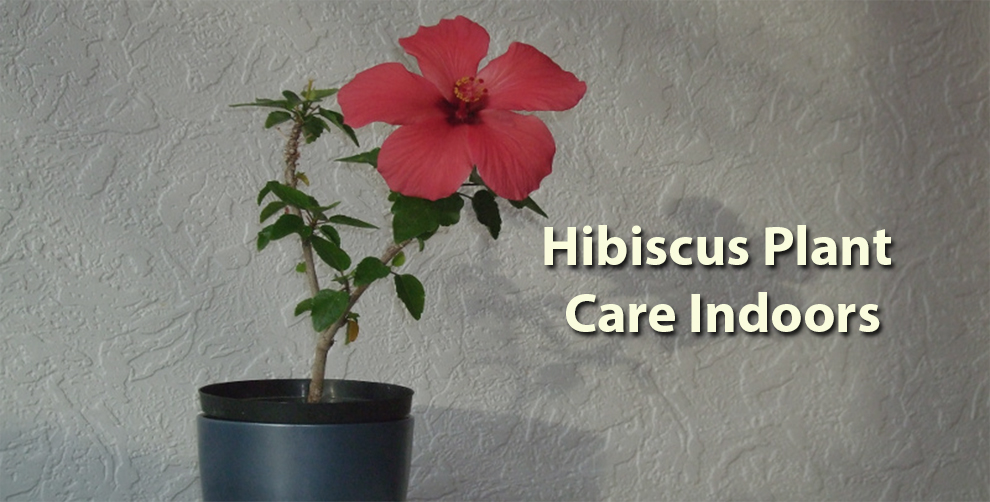
Hibiscus plants are beautiful flowering plants. They can thrive as houseplants. If you have one of these as your indoor mates but are struggling with how to care for a hibiscus plant indoors, here’s a sigh of relief for you.
Fortunately, hibiscus is easy to care for. But naturally, like other plants, even hibiscus has some specific care requirements that you must bear in mind to keep them thriving indoors.
Choosing the correct variety and planting it in a decently sized pot is the first step towards hibiscus plant care indoors. This is followed by thorough watering, bright indirect light, and a balanced fertilizer.
The absence of any one or combination can prevent your plants from looking healthy and blooming.
Further, you must routinely monitor them for diseases and pests to ensure they do not damage the plant. So, whether you are new to indoor plant care or an experienced gardener, with the correct knowledge, it will be easier to grow beautiful and thriving hibiscus plants indoors.
Can A Hibiscus Plant Survive Indoors or Should I Move It Outside?
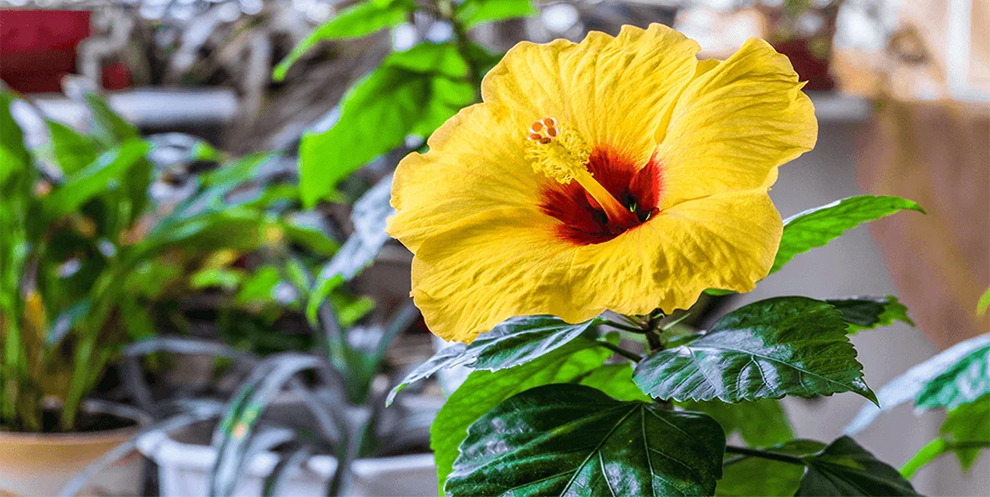
Yes, the hibiscus can survive and thrive indoors, provided you offer it the necessary hibiscus plant care indoors that it needs to survive.
Even though they are typically grown outdoors in subtropical and tropical regions, you can plant hibiscus indoors in any climate. The plant needs plenty of direct, bright sun to produce beautiful flowers. Hence, you must plant them indoors in a sunny location with high humidity.
How To Take Care Of Hibiscus Tree Indoors?
Here is a detailed guide on caring for hibiscus plants indoors. Be rest assured, if you follow it to T, your hibiscus will bloom and continue adding a vibrant and tropical vibe to your indoor space:
A. Pick the hibiscus variety suited for indoors
The first and foremost important thing is, to begin with, the correct variety of hibiscus flowers. Even though there are several kinds of hibiscus available, only some are suited for indoor growing. Here are some options you can consider:
1. Tropical Hibiscus is the most popular variety for indoor growing because of the ease of care and showy flowers. You can find them in various colors, including yellow, orange, pink, and red. These can also be double or single-flowered.
2. Chinese hibiscus is another popular variety with showy, large flowers in colors like orange, yellow, pink, and red.
3. Hardy hibiscus is also a good pick for indoors. They can tolerate cooler temperatures than other varieties. These produce showy, large flowers in pink, white, and red.
4. Rose of Sharon is also suitable for indoor growing. However, it can grow pretty big and may need a bigger container. It produces beautiful flowers in purple, pink, and white.
B. Planting your hibiscus in the right container
Please be cautious when selecting the container material and size. It is essential for its health and well-being.
1. Material: You can plant the hibiscus plants in porous containers with good aeration and drainage. Terracotta pots are an excellent choice. They regulate soil moisture levels and are breathable.
Plastic containers are another option. They are durable, lightweight, and retain moisture better than terracotta. Whichever material you select, ensure it has drainage holes to avoid water accumulation to prevent root rot.
2. Size: The pot size depends on the plant’s root system and size. Generally, the container must only be slightly bigger than its root ball. When you pick a pot that is too large, it can make the soil excessively moist, resulting in root rot.
On the contrary, a small container curtails plant growth and nutritional deficiencies. As a general rule, select a container that is 1 to 2 inches bigger in diameter than the current one.
3. Depth: Beyond the pot’s width, depth is also crucial. Hibiscus has deep roots. Hence, a shallow container may hamper root growth and the plant’s overall health. Thus, opt for a pot that is 12 inches deep.
C. How to look after indoor hibiscus plants’ light requirements?
An indoor hibiscus needs a lot of indirect, bright sun to thrive. Ideally, they must receive at least six hours of filtered, bright sun daily.
South-facing windows are ideal for them, as they offer the most light across the day. But if you do not have a south-facing window, you can keep your hibiscus near an east or west-facing window.
Please understand that even though hibiscus needs a lot of sunlight, you must not expose them to direct sun, especially during the hottest times of the day. Direct sun can burn the leaves and damage the plant.
If you are concerned about the hibiscus getting too much sun, place a shade cloth or sheer curtain over the window to filter the light.
If you’re unable to decide how to care for hibiscus indoors when you do not have a location that offers bright, indirect sunlight, you can consider using artificial lighting. Grow lights can be beneficial to ensure the plant gets the necessary light.
D. Which Indoor hibiscus soil should you use?
Picking the correct soil is a vital factor in hibiscus. Here are some tips for selecting the suitable plant soil:
1. Well-draining: Hibiscus plants thrive in well-draining soil that lets excess water drain away from the roots. When the soil retains too much moisture, it can lead to root rot and be fatal for the plant. You can employ a commercial potting mix, exquisitely formulated for indoor plants, or make one at home by mixing equal parts vermiculite, perlite, and peat moss.
2. pH: Hibiscus cherishes slightly acidic soil with 5.5 and 6.5 pH.
3. Nutrients: The soil should be rich in nutrients like potassium, phosphorous, and nitrogen. You can also use a liquid or a slow-release feed formulated for flowering plants to offer the correct nutrition to the hibiscus.
4. Moisture: Keep the soil around the plant continually moist but not wet.
E. How often should I water my hibiscus inside?
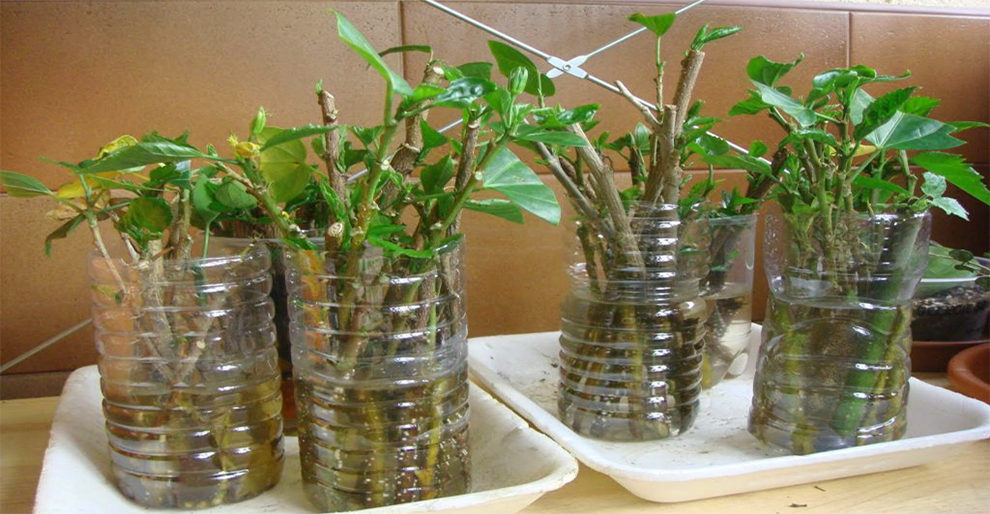
The watering frequency depends on various factors, such as the soil type, pot size, humidity, and temperature around the home. So, if you want to know how to care for a hibiscus tree indoors, you must be well-versed in its watering schedule. Here are the tips you can follow:
1. Inspect the soil by sticking your finger into the soil. If the topsoil feels dry, you can water it.
2. Water thoroughly until the water starts draining from the pot’s bottom. It helps keep the root system moist.
3. Do not overwater, as it may lead to root rot and can be fatal for the plant. Ensure the container has good drainage to eliminate excess water from the pot.
4. Adjust the frequency based on your plant’s needs. Generally, hibiscus needs watering every seven to ten days. However, this may vary depending on the available conditions and environmental factors.
F. Temperature and humidity required by hibiscus
Hibiscus plants prefer high humidity and warm temperature. Generally, they thrive in temperatures between 60 and 75 degrees. Anything below 55 degrees can cause damage to the plant. Thus, you must plant the hibiscus in a location that stays within the temperature range.
Do not keep the hibiscus in a cold or drafty area, such as near a window or door that is open frequently.
As for the humidity, hibiscus plants prefer a humid environment. Indoor environments tend to be dry, especially during the winter when the heating systems are running.
Hence, it is vital to take measures to improve the humidity around the plant. One way to do this is by using a humidifier near the plant that adds moisture to the air. You can also place a water tray near the plant or group multiple plants to establish a humid microclimate.
G. Indoor hibiscus fertilizer
Feeding the indoor hibiscus is crucial for hibiscus plant care indoors, as it offers the plant the vital nutrients necessary to bloom and grow. Some tips involved in fertilizing the indoor hibiscus are:
1. Pick the correct plant food: Hibiscus plants prefer fertilizers rich in potassium, nitrogen, and phosphorous. Pick a balanced fertilizer, exquisitely formulated for the flowering plants. You can also opt for a liquid or a slow-release fertilizer that you apply for two to three weeks during the growing season.
2. Apply the fertilizer evenly over the soil around the plant’s base. Please do not put it on the stems or the leaves, as that can lead to burning.
3. Water well after fertilizing to ensure it gets absorbed by the roots evenly.
4. Change the fertilization schedule based on the plant’s needs: The fertilizing frequency depends on the hibiscus plant’s needs. Generally, hibiscus plants need fertilizing every two to three weeks during the growing season. But alter the frequency based on the plant’s health and growth.
H. Hibiscus indoor plant pruning
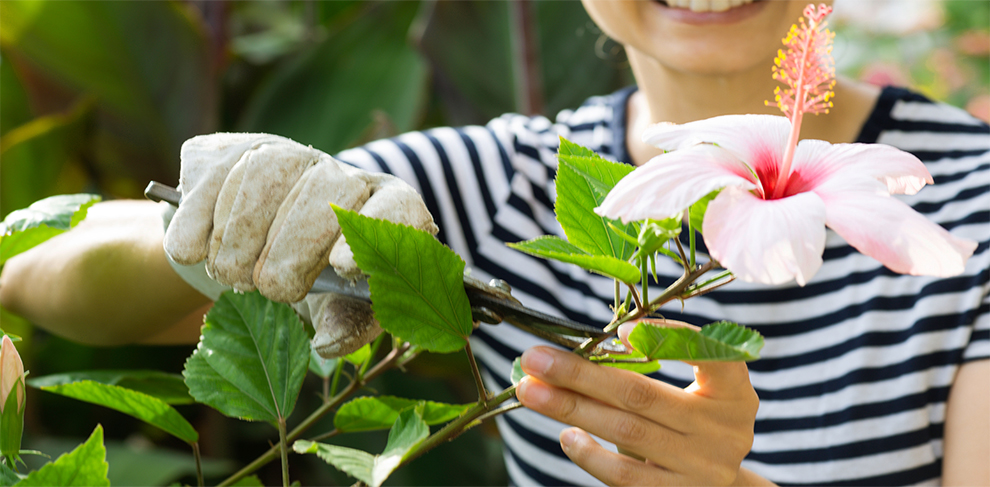
Pruning the hibiscus is a crucial aspect of the hibiscus care routine. Regular pruning can help keep the plant healthy, encourage more blooms, and promote new growth. Here are some tips to follow:
1. Timing: You must prune the hibiscus in early spring or late winter before new growth starts.
2. Tools: You will require sharp, clean pruning shears to make clean cuts and avoid damaging the plant.
3. Deadheading: Remove the spent blooms by cutting off the flower stem slightly above the first set of leaves. It facilitates more blooms.
4. Pinching: Pinch off the new growth to encourage more branches and bushier growth.
5. Shaping: To shape the hibiscus, prune the leggy or overgrown branches to the requisite length. You can remove the diseased or damaged branches.
6. Maintenance: Prune the hibiscus around the year to encourage new growth and keep them healthy. Ensure that you clean the shears with rubbing alcohol between two cuts to prevent disease spread.
Even though hibiscus is resilient and can tolerate a fair amount of pruning, do not remove excessive foliage at once, as that can stress the plant and hamper its growth. A little pruning regularly is the best way to keep the indoor hibiscus looking beautiful and healthy.
I. Repotting hibiscus – how to take care of hibiscus indoors after repotting?
Repotting the indoor hibiscus is also a crucial aspect of the care routine. Over time, the plant grows its current pot and requires more space for growing. Here are some repotting tips that can help:
1. Timing: You must consider repotting in the spring before the growing season starts.
2. Pot selection: Opt for a slightly larger pot than the current one. Ensure that it has drainage holes to drain excess water.
3. Soil selection: Plant it in well-draining soil with rich organic matter. You can also add sand or perlite to improve drainage.
4. Process:
- Remove the plant from the current pot cautiously to not damage the roots.
- Loosen any tangled roots and remove the diseased or dead ones.
- Place a soil layer at the bottom of the new pot and keep the plant in the container.
- Fill the sides with soil, pressing down to ensure good contact between the soil and roots.
- Once repotted, water the plant thoroughly to help the soil settle and encourage new root growth.
5.Maintenance: After repotting, the plant may experience some transplant shock. So, keep the plant in a shaded spot to reduce watering till the plant has had ample time to adapt to the new pot.
Do not repot the hibiscus plant too frequently, as that can damage and cause stress to the roots. Typically, you must repot every 1-2 years or when the plant outgrows its current pot.
Related: How long do hibiscus plants live?
How To Take Care Of A Hibiscus Plant Indoors In Winter?
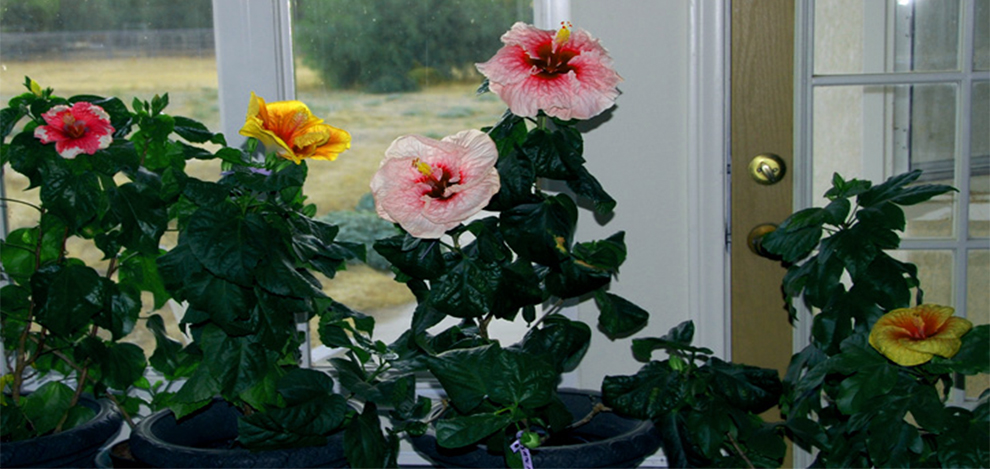
Taking care of indoor hibiscus during winter is crucial to ensure the plant stays healthy and continues to thrive. Here are some tips for caring for hibiscus indoors during winter:
- Do not place it near areas with fluctuating temperatures or cold drafts.
- In the winter months, the days are shorter. Moreover, the sun is less intense. To compensate, move the plant to a location that receives bright, indirect sun for at least six hours daily.
- In the winter months, hibiscus does not need as much water. So, let the soil dry partially before rewatering. Do not overwater, as it can cause root rot.
- The plant prefers high humidity. In winter, indoor heating can dry the air and harm your plant. Use a humidifier or place a water tray near the plant to amplify humidity. You can also regularly mist the leaves.
- In winter, hibiscus plants need less feed than in the warmer months. So, lower the fertilizing to once a month, and use a balanced fertilizer.
- During the winter months, the plants slow down their growth. Hence, you can prune the plant and stimulate bushier growth. You can remove any diseased or damaged branches.
Why Is My Indoor Hibiscus Dying – Am I Missing Something?
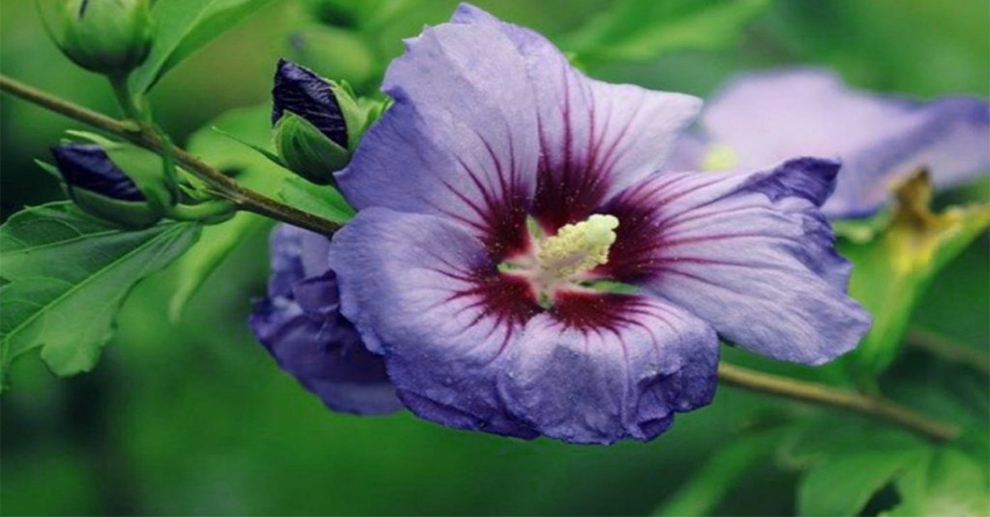
Several factors may be responsible for a dying hibiscus. A few possible reasons include
1. Watering: Under or overwatering the hibiscus can cause it to wilt and die. So, ensure that your water correctly, letting the soil partially dry between the two watering.
2. Lighting: Hibiscus plants need indirect, bright sun to thrive. If the plant does not get enough light, it may lose leaves and become weak.
3. Temperature: The hibiscus plant cherishes warm temperatures and does not tolerate cold weather. So keep the plant away from cold drafts or areas with fluctuating temperatures.
4. Humidity: The hibiscus plant thrives in higher humidity. So, if the air around the home is too dry, it may cause the plant to become unhealthy and wilt.
5. Soil: The hibiscus plant requires well-draining soil rich in organic matter. Ensure the plant is in the correct soil and the pot has ample drainage.
6. Pests and diseases: Hibiscus plants can be susceptible to spider mites pests and diseases like powdery mildew. So, inspect the plant regularly for any signs of infection, and take measures as needed.
7. Repotting: When the plant outgrows its current container, it may become rootbound and begin to decline. So, repot it in a larger pot.
You must identify why the plant is struggling and take action to correct the problem. With proper hibiscus plant care indoors and attention, the plant can recover and thrive.
